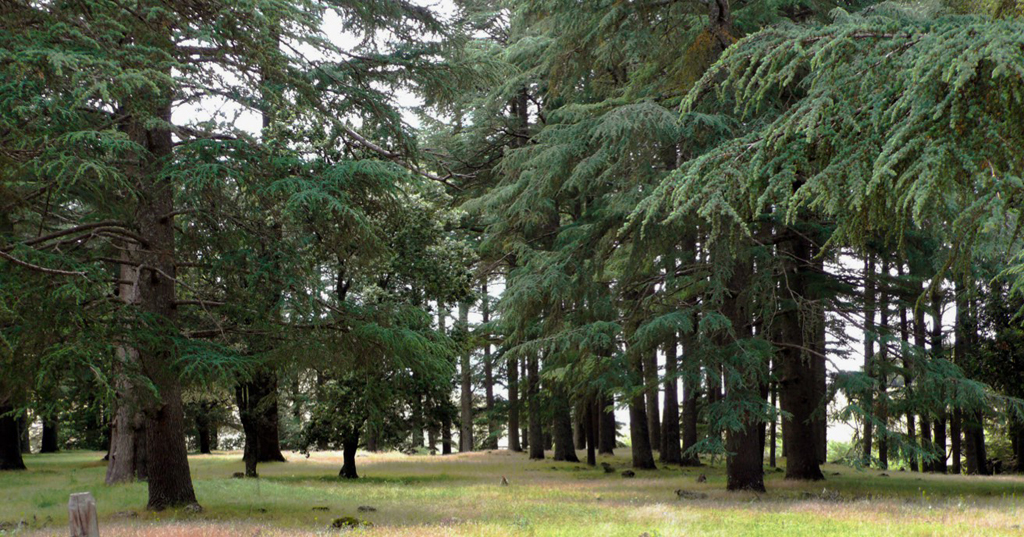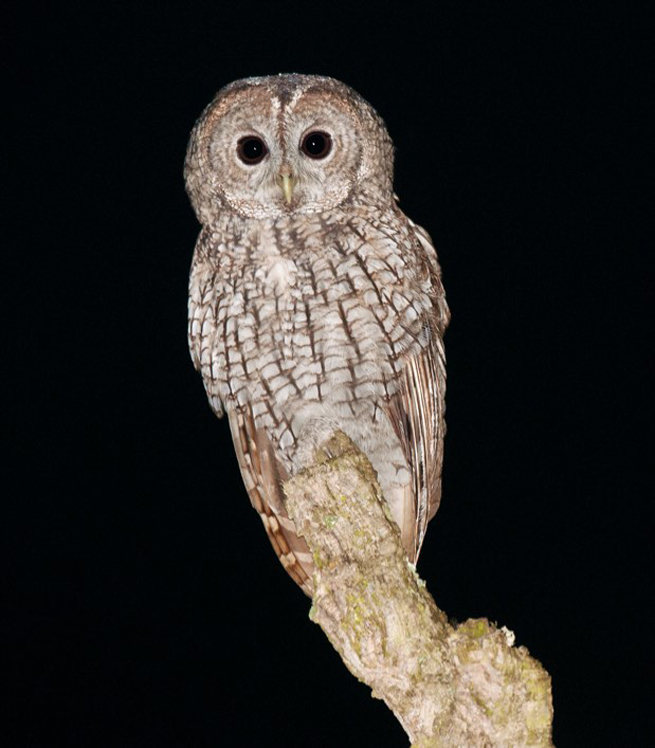‘The Maghreb’ traditionally consists of the Atlas mountains and the coastal plains from Morocco to Libya. Arnoud has recorded Maghreb Wood Owl Strix mauritanica in Tunisia and many sites in Morocco. One of the most beautiful was the Atlas Cedar Cedrus atlantica forest near Azrou in the Moyen Atlas, about 1700 m above sea level. In late June 2010, Arnoud and Cecilia stayed there for a few days. They focussed on some gravel tracks where they had previously found family groups of Barbary Ape Macaca sylvanus foraging in mature woodland of pine Pinus, cedar and oak Quercus.
On the evening of 23 June, there was a bright moon when Arnoud heard a male hooting high in an enormous cedar. He rolled his car slowly under the tree and pushed the microphones through the window, onto the car roof. In CD4-32, the male and a rival in the next territory are compound hooting.
CD4-32: Maghreb Wood Owl Strix mauritanica Forêt de Cèdres, Azrou, Western Middle Atlas, Morocco, 23:29, 23 June 2010. Compound hooting of two males, one near and one far. Background: European Nightjar Caprimulgus europaeus. 100623.AB.232900.11

Habitat of Maghreb Wood Owl Strix mauritanica, Forêt de Cèdres, Azrou, Western Middle Atlas, Morocco, 12 June 2010 (Cecilia Bosman). Mixed cedar wood with Barbary Apes Macaca sylvanus. Same site as in CD4-32.
When Arnoud first played me recordings of Maghreb Wood Owls, I agreed with him that they sounded odd. At the time I was unable to say why, except that they sounded deeper than Tawny Owls S aluco, as if they had ‘somebody else’s voice’. Now having just spent three weeks listening to hundreds of recordings of Tawny, I hear another difference straight away. Listen to the second of the three parts, the double note coming after the long gap. Tawny only ever has a single note in this position, or up to three single, well-separated notes in females. Believe me, I went back and checked!
Now listen to one of those earlier recordings that Arnoud made in the same area back in 2002 (CD4-33). It also features two males, both doubling their second note. To me, the more interesting male is the distant one. Its first two compound hoots have total duration of 11 and 12.8 sec, respectively. This is incredibly long for a Strix owl, and in fact Maghreb Wood Owl’s compound hoots average around 20% longer than those of Tawny Owl. They also average around 20% lower-pitched. This refers to the normal, calm version of the compound hoot. When the owls become more excited, their hoots change dramatically.
CD4-33: Maghreb Wood Owl Strix mauritanica Forêt de Cèdres, Azrou, Western Middle Atlas, Morocco, 21:17, 26 March 2002. Compound hooting of two males, one near and one far. Means based on 14 solo males from widely scattered locations in Morocco and Tunisia (each male’s mean based on three compound hoots). Background: Eurasian Scops Owl Otus scops. 02.004.AB.11948.22
CD4-34 shows how normal compound hoots change to excited ones when a female joins a male during an autumn territorial dispute. A second male is hooting in the distance, and the female’s arrival emboldens her mate’s response. First he gives two compound hoots with duration of c 7.5 sec. When he starts a third, the female joins in with her own higher-pitched, shorter version. The male’s subsequent, more excited compound hoots are very different and only half as long. They have not one but two sets of doubled notes in the middle, and these are much lower-pitched than in normal compound hooting. Maghreb Wood Owl and Tawny Owl differ much more strikingly from one another in these excited, shorter versions of the compound hoot than in the full length, more stereotyped version.
CD4-34: Maghreb Wood Owl Strix mauritanica Dar es Salam, Rabat, Zaër, Morocco, 20:34, 1 October 2009. Compound hooting of a male, and from 0:57, a female, followed by excited compound hooting of male. Background: compound hooting of a distant male. 091001.AB.203440.02
Arnoud recorded CD4-35 at the same spot in Cork Oak Q suber woodlands near Rabat, early the next morning. The recording starts with the male’s compound hooting and some rather prolonged soliciting calls of the female, which are lower-pitched than those of Tawny Owl. Both male and female gradually evolve towards excited compound hooting, then revert to their previous sounds.
CD4-35: Maghreb Wood Owl Strix mauritanica Dar es Salam, Rabat, Zaër, Morocco, 05:38, 2 October 2009. Male compound hoots, becoming shorter, and female soliciting calls, becoming more urgent. From 0:32 the male switches to excited compound hooting and from 0:36 the female joins in. 091002.AB.053856.32

Maghreb Wood Owl Strix mauritanica, adult, Dar es Salam, Rabat, Zaër, Morocco, 1 October 2009 (Arnoud B van den Berg). Same bird as in CD4-34. Witherby (1905) described Maghreb Wood Owl for science thus: “Differs from typical Syrnium aluco [Tawny Owl’s scientific name at the time] by its constantly darker coloration. The whole of the upper surface dark blackish grey, the dark colour being produced by the heavier and more pronounced transverse bars on the feathers. The feathers of the underside also much more heavily marked with transverse bars than in typical S aluco. Although Syrnium aluco is very much disposed to individual variation, the birds inhabiting Marocco [sic] and Algeria are remarkably constant in their coloration.”
Soliciting calls of Maghreb Wood Owl are similar to those of Tawny Owl but lower-pitched and slightly harsher in females. Arnoud has not yet recorded a male giving this call. In CD4-36, a female at Dar es Salam gives a series of soliciting calls, until a male answers with a compound hoot. In the long gap after his first note, the female inserts some rather eccentric, excited compound hooting of her own. It has two sets of ‘middle notes’: a very slow double at a high pitch and a faster double at a very low pitch. In her second compound hoot a few seconds later there are also two sets of middle notes. This time they differ in pitch, but less so in speed.
CD4-36: Maghreb Wood Owl Strix mauritanica Dar es Salam, Rabat, Zaër, Morocco, 21:14, 4 October 2006. Soliciting calls of female, then compound hooting of male and excited compound hooting of female. 06.013.AB.12615.32
Hamdine et al (1999), studying pellets from two sites in Algeria, found that its diet consists mainly of mammals (43.6%) and birds (29.3%) but also includes a high proportion of amphibians (15.2%), reptiles (11.8%), and even invertebrates (14.7%). Maghreb Wood also lives in towns, which often support trees in areas that would not otherwise have them, such as for instance Marrakech and Taroudant.
Pulsed hooting of Maghreb Wood Owl is similar to that of Tawny Owl but much lower-pitched. Arnoud has made only one recording where it was sustained for more than a second or two, and that was from a wooded camping ground in the town of Larache (CD4-37). In one or two other recordings it appears only momentarily in male-female interactions. The pulse rate appears to be similar to that of Tawny, despite the difference in pitch.
CD4-37: Maghreb Wood Owl Strix mauritanica Larache, Rharb, Morocco, 00:14, 27 March 2006. Pulsed hooting of a presumed male and compound hooting of a presumed female. 06.002.AB.01153.11
Most nights in autumn, birds migrate over my house on the Portuguese coast and the majority must continue on into Morocco. The Ortolan Bunting Emberiza hortulana migrating overhead in CD4-38 may have flown over as I slept, just a night or two before. The male Maghreb Wood Owl hooting beneath it is another with a particularly long compound hoot: around 10 seconds long. In the background from 0:35 a second, more distant individual gives a deep keh-keh-keh-keh…, which is probably Maghreb Wood’s equivalent to the distance call of Tawny Owl.
CD4-38: Maghreb Wood Owl Strix mauritanica Dar es Salam, Rabat, Zaër, Morocco, 18:51, 4 October 2007. Compound hooting of a male, and presumed distance calls of another individual. Background: migrating Ortolan Bunting Emberiza hortulana. 071004. AB.185154.21
Maghreb Wood Owls reach their northernmost limit at the Strait of Gibraltar. The Tawny Owls of southern Iberia just to the north are much smaller, with calls and plumage similar to those found elsewhere in Europe (cf, CD4-17). Unlike the Moors, then, Maghreb Wood seems never to have made the 15 km crossing to Europe.
Despite their differences, calls of Maghreb Wood Owl and Tawny Owl are similar enough to suggest that they shared a common ancestor not so far back in the past. Brito (2005) estimated this to have been not more than half a million years ago. Her genetic study showed that Maghreb Wood is a completely separate entity from Tawny in Europe. Maghreb Wood’s plumage is also strikingly different and only comes in a grey morph, whereas Tawny varies across a spectrum from greyish to reddish. The combination of vocal, genetic and morphological differences from Tawny suggests that Maghreb Wood is best treated as a separate species.
In the deserts of the Middle East there is a smaller Strix owl with orange eyes. Its shared ancestor with Maghreb Wood Owl and Tawny Owl lived sometime further back in the past. Until recently this poorly known species was sometimes lumped with Tawny, but if earlier generations had known how different it sounds, they might never have made this mistake.

